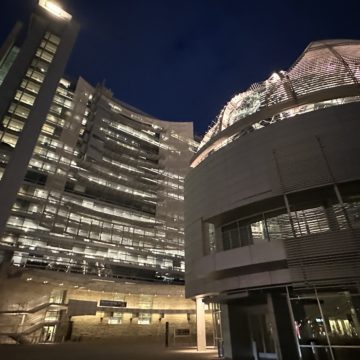From Disney resorts to animal funeral services, San Jose City Hall employees spent millions with city credit cards this past year.
About a quarter of San Jose employees have city-funded credit cards, known as purchase cards or P-cards. The cards are typically issued to specific department representatives with intent to streamline small dollar purchases—mostly office supplies, tools, food, low-cost equipment and travel expenses. This is part of the 1990 statewide program with U.S. Bank that allows government employees to have credit cards with particular limits, such as a cap of $1,000 per transaction to prevent high purchase fraud. San Jose employees with P-cards are capped at $10,000 a month.
In 2022, 987 employees made about 45,400 purchases totaling $15.4 million, according to data reviewed by San José Spotlight.
Last year, city workers spent $4,000 on cremation and funeral services for animals from the city’s shelter, $71,000 for shoes and $17,000 at different bowling alleys across the South Bay, to name a few unique expenditures. The P-card program is overseen by the city’s finance department, but oversight of transactions is managed individually by each department.
Travel was another big expense at more than $600,000—$381,000 on hotels and $245,000 on airfare, in addition to spending on car rentals and other travel expenses. While travel to overnight conferences is typical for various city employees, some hotel picks included the Disney Resort, more than $1,000 at the Ritz Carlton hotel in Half Moon Bay and stays at the 5-star Venetian Hotel in Las Vegas.
Carolina Camarena, spokesperson for the city manager’s office, said the hotels in question received discounts because of nearby conferences — something that typically occurs.
“When conference hotels are not available, travelers may stay at alternate hotels with the most economical rates,” Camarena told San José Spotlight. “The city travel policy requires travelers to seek lodging options that provide safety and convenience to the traveler, at the lowest possible cost.”
Spending by department
Parks, Recreation and Neighborhood Services Department officials said spending was typical with $4.1 million charged last year—the highest bill of any city department last year. Parks has the most authorized P-card users—220—though it is one of the largest departments in the city with more than 800 employees.
The department paid for outings to bowling alleys, spent $71,000 at amusement parks and more than $450,000 on Amazon—although it’s not clear what was purchased and the city did not clarify specifics. The department also spent $116,000 at restaurants and $32,000 on advertising services.
But department directors say the spending is related to business the department conducts.
David Delong, parks division manager for administration services, said the amusement park and bowling alley trips are expenses employees made as part of city-run youth programs, which take participants on field trips. The parks department has 36 recreational programs for school kids and teens and 19 preschool programs — and this doesn’t include youth that the department serves in programs at parks, leisure, aquatics and youth intervention, according to the department.
“Primarily, the ‘fun spending’ is going to be camps for kids, teen centers and intervention services,” Delong told San José Spotlight. “If you have any kind of youth outreach and intervention services that our staff are leading, you take them out to lunch to develop that relationship with them in hopes of kind of steering them in the right direction.”
Lois Varga, another administrative officer who oversees finances and budget for the parks department, said the P-card money being spent is already allocated in the annual budget—it’s not extra money the department spends just because it can.
“We can’t spend $1 that’s not budgeted. It is very, very strict what we use the money for,” Vargas told San José Spotlight.
Public Works, the department with the second highest amount of P-card charges, spent about half of what parks did at $2.4 million. Workers spent hundreds of thousands on automotive parts, plumbing services or equipment and other construction-related purchases. The department also spent $237,000 on Amazon, and the city did not disclose details of the purchases. Another notable expense, $205,000, was veterinary services and pet food for the city’s animal shelter.
The San Jose Police Department ranked third in the city with nearly $2 million spent. Surprisingly, about $325,000 went to travel-related expenses including flights and hotels—more than a third of total travel expenses charged to P-cards citywide. Police charged $4,000 on booths to recruit new officers, $18,500 on fast food and $73,000 at restaurants.
In comparison, councilmembers and their staff did not spend nearly as much with their P-cards—with a total of $320,000. Kiara Arreola, deputy chief of staff for former District 5 Councilmember Magdalena Carraso, spent the most at $44,000. City data shows she made a $550 charitable donation to the Boy Scouts of America, several Amazon purchases, a Canva subscription and more than $1,000 on Venmo—though it is not clear why or who received it.
Carrasco’s office had the most P-card charges by a considerable amount with $59,000 spent. Former District 7 Councilmember Maya Esparza’s office spent $38,000 and District 4 Councilmember David Cohen’s office spent $35,000. District 6 Councilmember Dev Davis’ office spent $29,000. The rest of the council offices spent approximately $14,000 each on average, with the exception of former Vice Mayor Chappie Jones’ office which spent $1,800.
Problems with fraud?
P-card spending has varied over the last five years—with the biggest jump from 2021 to 2022. In 2018, the city spent $13.7 million. In 2019, that jumped to $14.4 million, but took a notable dip in 2020 with $11.7 million spent during the COVID-19 pandemic. In 2021, the city spent $11.3 million through P-cards.
The city auditor’s office, which analyzed P-card purchases in 2018-19, found most transactions complied with city policies, but noted some gaps.
These included recurring purchases of water for personal use, technology purchases made without approval from the Information Technology Department and not properly identifying and recording items greater than $5,000. Four former city employees still had active P-cards after they stopped working for the city. Many of these issues persisted from prior audits, especially in the parks department which was called on to strengthen its oversight on P-card purchases.
Jason Zirkle, training director for the Association of Certified Fraud Examiners who previously oversaw P-card usage for the Texas Department of Public Safety from 2011-19, said any place where there are P-cards there is likely fraud—but it will likely be on small personal purchases that fly under the radar. The only sure way to catch potential fraud is for a department to be judicious about oversight, he said.
“If you have more people stealing some smaller sums, it may functionally be the same thing as one person (who) comes in and steals a million dollars,” Zirkle told San José Spotlight. ”But what are they going to focus on? They’re going to focus on the one person stealing a million dollars.”
Zirkle said the best way to avoid fraud is to have multiple checks and balances. In San Jose, there is a supervisor in each department who oversees transactions monthly. If something is flagged out of concern, it is investigated. If it’s a violation of the city policy, a memo goes to the finance department and the money is required to be reimbursed by personal funds.
Zirkle said this policy is typical for most local governments. The only way to make it work thoroughly though is to make sure supervisors pay attention to every transaction.
“What’s the oversight? Are your employees trained? Is there an ethical culture within the city?,” Zirkle said. “Pretty much all that stuff converges together to determine how much fraud there is, otherwise it’s just really hard to determine.”





